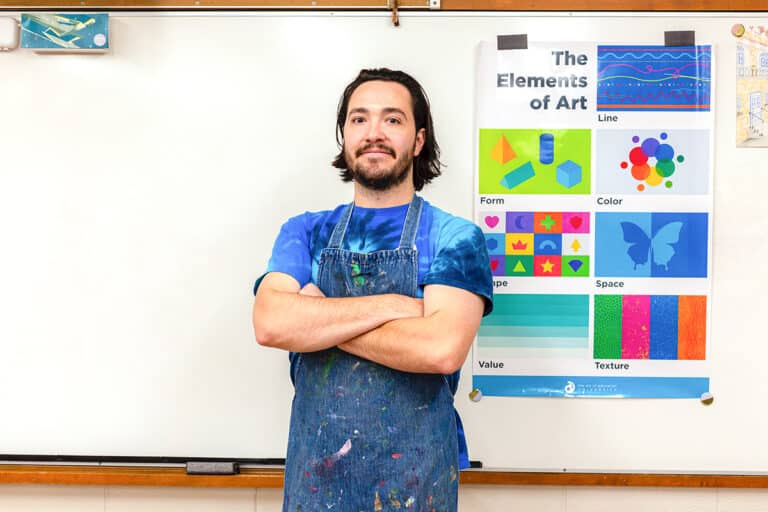As summer approaches, there is no better time to begin, or perfect, your venues for communicating with parents, families, and the larger art ed world. Devote some time this summer to explore your communication options. Choose something that is enjoyable for YOU to keep up with, or revamp what you’re already doing to suit your scheduling, professional, and aesthetic needs. It’s best to pick one avenue versus spreading yourself thin over multiple platforms. Take time this summer to evaluate what it is you want your families, students and followers to know and personalize your communication style to match those needs.
Here are 15 fantastic choices for communicating with parents and families.
1. Twitter
See my article here about why you should create a classroom Twitter. Twitter is a social network that allows users to communicate, in 140 characters or less, in text called a “tweet.” Depending on privacy settings, these tweets may be made viewable to the public or seen privately by the user’s followers (i.e. your parents and families). See my Twitter here.
2. WordPress
WordPress is a free blogging platform with customizable templates. Most bloggers will choose between this and the Google platform Blogger. eastartroom, one of the Top 10 Art Ed Blogs of 2013, is one example!
3. Blogger
Blogger is the free blogging platform owned by Google. All you need is your Gmail account! Some of my favorites, Art with Mr. E and Mini Matisse, use Blogger.
4. Weebly
Weebly is an amazing website builder with customizable options and the ability to upload from anywhere. Watch more here by clicking “Watch the Video”. See this great iPad weebly from Theresa Gillespie!
5. LiveBinder
This is a virtual binder to help your organize resources and content. Check out this awesome LiveBinder from fellow art educator Theresa McGee.
6. Smore
Create free digital newsletters that can be customized and sent out instantly. There’s even a special smore educator program if you love the free pages and want to take it to the next level with some paid features.
7. Symbaloo
This awesome site arranges all your bookmarks and websites for classroom resources, blogs, art sites, art games, etc. in a pretty tile format that is stored in the cloud. Think, easy access to digital portfolios!
8. Flickr
Like the idea of a photo blog or want to store all your project photos in one place? Flickr is the tool for you! See how Chelsie uses Flickr to Create Digital Portfolios.
9. Facebook
The famed social networking site isn’t just for posting your latest Meme find or online quiz results. You can actually create a page for your classroom to keep families updated on the latest and greatest from your classroom. Choose to create a page versus an entire profile so that followers may only “Like” your page. This also makes it much easier to control comments and who may see your posts. One of my favorite Facebook pages is SHHS Art Department.
10. Remind 101
Remind 101 is a free one-way text messaging service that allows you to text your students and parents without giving out your actual phone number. All the phone numbers are kept private and anonymous. You even have the ability to schedule these texts!
11. Instragram
This is the free, quick and easy, snap and share app that allows you to post from anywhere. Share pictures of your favorite products, classroom organization ideas, current projects, student work, and displays! Check out this absolutely amazing post on abbyescart about the many uses for Instragram in the art room.
12. Google sites
Access to Google sites is another perk of being a Gmail account holder. Use one of Google’s many tools to build a free website.
13. Email
Compile a list of parent emails at open house, use your school’s messenger system, or use your school’s directory to contact families through one of their most frequented communication avenues.
14. Paper Newsletters
Good old fashioned paper newsletters allow you to reach those parents and families who may not have access to computers or other digital avenues, or those who prefer physical copies. Sometimes having the physical paper is more memorable and easily noticed.
Blurbs in your school newsletters
If you want to keep your contact short, sweet, and to the point, add a blurb to your school’s weekly or monthly newsletter. You can also always check with classroom teachers if there is a specific grade level you wish to communicate with. They may be willing to put a blurb in their newsletter, or even post for you through their digital communications.
**Note: Please use common sense when posting about your students or school. You may want to check your district’s policies on social networking for classroom purposes before beginning some of the options listed above. There may be restrictions you aren’t aware of. In the same vein, attain parent permission and consult your school’s no-media list of students if posting about students.**
How do you communicate with parents and families? Have you tried any of the ideas above? Are there any missing?
Do you set time aside to use social media, or do you find it difficult to fit it in?
Magazine articles and podcasts are opinions of professional education contributors and do not necessarily represent the position of the Art of Education University (AOEU) or its academic offerings. Contributors use terms in the way they are most often talked about in the scope of their educational experiences.





